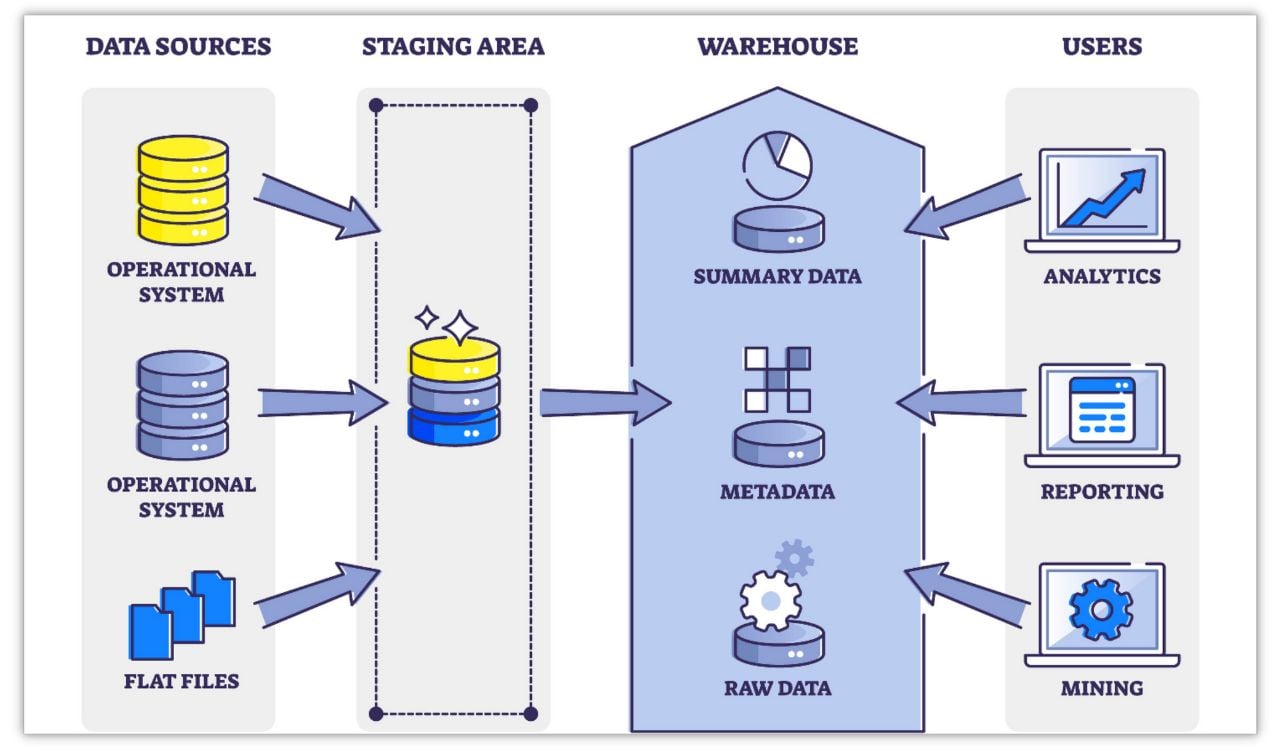Today, organizations collect, store and manage more data than ever before. Research shows that the average company manages 162.9TB of data, with large enterprises having upwards of 347.56TB – seven times as much data as the average SMB with 47.81 TB.
The problem is that as much as 73% of that data goes unused due to it being so difficult to organize. Data silos make it almost impossible to gain actionable insights from the data organizations collect, leading to data inefficiencies and bottlenecks and ultimately less value.
That’s where data warehousing can help.
This article delves deep into data warehousing, exploring its meaning and benefits while giving real-world examples of the process in action.

What is data warehousing? Definition
Data warehousing is a process of collecting, storing, and organizing large amounts of data from various sources into a central repository for analysis and reporting.
It goes beyond simply storing data, extracting, transforming and loading data from diverse sources (databases, applications, sensors, etc.) into a central, subject-oriented store. This "warehouse" acts as a single source of truth for historical and current data.
Unlike operational databases optimized for speed, data warehouses prioritize organization and accessibility for analysis. Data is structured, cleansed, and organized by subject area (e.g., sales, marketing, finance) for efficient querying and reporting.
While operational databases handle real-time transactions, data warehouses store historical data for trend analysis, forecasting, and identifying long-term patterns.
They also integrate with business intelligence (BI) tools and analytics platforms. Users can slice, dice, and analyze data to uncover hidden trends, identify correlations, and measure performance against goals.
How does data warehousing work?

The three layers of data warehousing
Data warehousing typically involves three main layers: the data staging area, the data warehouse and the business intelligence (BI) layer.
- The data staging area is where data from various sources (databases, applications, websites, etc.) is initially landed. Here, the data is cleansed, transformed, and standardised to ensure consistency before being loaded into the warehouse.
- The Data Warehouse is the central repository where the prepared data resides. It's usually optimized for analytical processing and organized into tables with well-defined schemas.
- Business Intelligence (BI) Layer provides tools and interfaces for users to access, analyze, and visualize the data in the warehouse. This could include reporting tools, data mining software, and dashboards.
The data warehousing process
In data warehousing, data is extracted from various sources. such as transactional databases, spreadsheets, flat files, external databases, and more, and stored in a central repository.
The extracted data is then cleaned, formatted, and transformed to ensure consistency and compatibility with the data warehouse structure. This involves removing duplicates, correcting errors, and converting data formats.
Once transformed, the data is loaded into the staging area and then transferred to the main data warehouse. Analysts and users can access the data through the BI layer for analysis, reporting, and insights generation. This may involve querying the data, creating reports, and visualizing trends and patterns.
Many organizations turn to data warehouse software for this process. These tools automate the data warehousing process by extracting, transforming, loading, managing, and analysing data automatically so that organizations don’t have to.
Popular examples of these tools include Microsoft SQL Server Integration Services (SSIS), IBM InfoSphere DataStage, and open-source tools like Apache Kafka and Apache Spark.
Why is data warehousing important?
The importance of data warehousing lies in its ability to address challenges associated with data management, analysis, and decision-making in modern organizations. The need for a data warehouse often becomes evident when analytic requirements go against the ongoing performance of operational databases.
Running a complex query on a database requires the database to enter a temporarily fixed state, which is impossible to maintain in transactional databases.
Data warehousing does all the analytic work so that transactional databases are free to focus on transactions. By bringing data from various sources into a single location, it allows for comprehensive analysis and comparison, leading to more informed decisions.
Benefits of Data Warehousing
1. Informed decision-making
Data is the lifeblood of any organization, and data warehousing provides a central repository of historical and current information. This allows businesses to analyze trends, identify patterns, and make informed decisions based on concrete evidence rather than gut feeling or guesswork. Imagine comparing sales data across different regions or product categories to understand what's driving success.
2. Improved efficiency and productivity
Data warehouses eliminate the need to manually collect and piece together data from disparate sources, saving time and effort. This allows employees to focus on more strategic tasks and higher-value activities. For example, marketing teams can quickly access customer data for targeted campaigns instead of manually compiling spreadsheets from multiple systems.
3. Enhanced data quality and consistency
Data warehouses enforce data standardization and cleansing processes, ensuring data consistency across the organization. This eliminates the risk of errors and inconsistencies that can lead to misleading conclusions. Think of having a single, reliable source of truth for customer information instead of relying on fragmented data from different applications.
4. Deeper data insights
By analyzing vast amounts of data from various sources, data warehousing helps uncover hidden trends, patterns, and correlations that wouldn't be apparent from individual datasets. This empowers businesses to gain a deeper understanding of their customers, operations, and markets, leading to a competitive advantage. For instance, analyzing customer purchase history and preferences can help identify upselling opportunities.
5. Regulatory compliance and risk management
In today's data-driven world, regulations are becoming increasingly complex. Data warehouses help organizations comply with data privacy regulations like GDPR and DORA by providing a centralized and secure location for data storage and access control. Additionally, data analysis can identify potential risks and vulnerabilities before they escalate.
6. Scalability and future-proofing
Data warehouses are designed to handle large and growing datasets, ensuring scalability as your business expands. This future-proofs your data infrastructure and allows you to incorporate new data sources and applications easily. Think of having a data storage system that adapts to your changing needs without breaking the bank.
Examples of Data Warehousing
Data warehousing has applications across diverse industries and functions, serving as a central hub for data analysis and insights for organziations big and small.
Here are some common examples of data warehousing across industries:
1. Enhanced Analytics in Retail
- Analyzing customer purchase history: Identify top-selling products, understand customer preferences, and personalize marketing campaigns based on demographics and buying patterns.
- Optimizing inventory management: Predict demand fluctuations, track stock levels across stores, and prevent stockouts or overstocking.
- Analyzing campaign effectiveness: Measure the impact of marketing campaigns on sales and identify the most successful strategies.
2. Reducing Fraud in Finance
- Identifying fraud and suspicious activity: Analyze transaction data to detect potential fraud attempts and protect customer information.
- Evaluating customer creditworthiness: Assess credit risk and make informed decisions about loan approvals and interest rates.
- Predicting market trends: Analyze financial data to forecast economic trends and make informed investment decisions.
3. Improving Healthcare and research
- Improving patient care: Analyze patient medical records to identify trends in disease outbreaks, track treatment effectiveness, and personalize treatment plans.
- Optimizing resource allocation: Analyze hospital data to understand patient flow, optimize staffing levels, and allocate resources efficiently.
- Conducting clinical research: Aggregate and analyze patient data to conduct research studies and develop new treatments.
4. Streamlining Manufacturing
- Optimizing production processes: Analyze sensor data from machines to identify bottlenecks, predict equipment failures, and improve production efficiency.
- Ensuring quality control: Track product quality through every stage of production and identify potential defects early on.
- Analyzing supply chain performance: Track inventory levels, monitor supplier performance, and optimize delivery routes.
5. Providing the public sector with key insights
- Analyzing crime patterns: Analyze crime data to identify hotspots, predict future crime occurrences, and allocate resources effectively.
- Monitoring public health: Track disease outbreaks, identify vulnerable populations, and implement targeted public health interventions.
- Understanding citizen needs: Analyze data from surveys and social media to understand citizen concerns and improve public services.
Final Thoughts
Data warehousing has evolved. Once considered a complex and expensive technology, data warehousing has become more accessible and cost-effective with cloud-based solutions and open-source tools.
Data warehousing isn't just about reporting and analysis anymore. It's increasingly used for advanced analytics, machine learning, and artificial intelligence, enabling organizations to predict trends, automate tasks, and make even more informed decisions.
In today's world, data is the new currency, and data warehousing plays a crucial role in unlocking its value. As data volumes continue to grow, organizations that leverage data warehousing effectively will gain a significant competitive advantage.







Comments ( 0 )